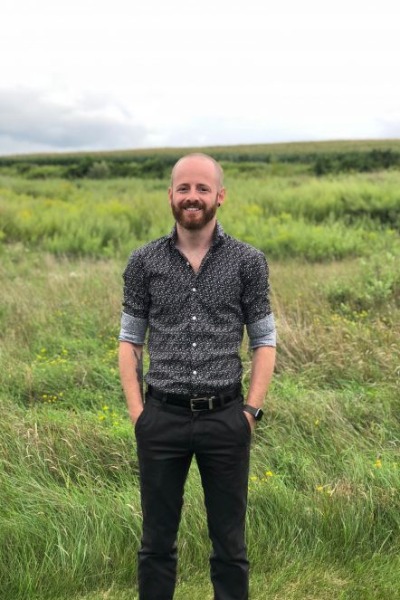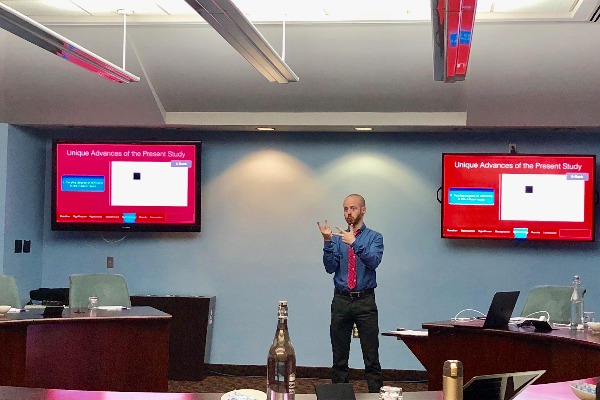Gallaudet’s Second Ph.D. in Educational Neuroscience (PEN) Doctoral Student Defends Dissertation


Geo Kartheiser successfully defended his dissertation on Tuesday, September 25 (Dr. Laura-Ann Petitto, advisor). Geo will be the PEN program’s second doctoral graduate.
Geo Kartheiser, Dr. Laura-Ann Petitto's doctoral student in Gallaudet University’s Ph.D. in Educational Neuroscience (PEN) program and a graduate research assistant in Dr. Petitto’s Brain & Language Laboratory for Neuroimaging (BL2), successfully defended his dissertation on "The Neuroplasticity of Spatial Working Memory in Signed Language Processing" on Tuesday, September 25, 2018.
Mr. Kartheiser’s study took as a starting point that spatial cognition has been shown to be enhanced in early-exposed, deaf signers of signed languages, possibly because signed languages are spatial in nature. However, spatial cognition is generally considered malleable across the lifespan. Unlike human language that requires exposure during critical developmental periods in early life, it has been a long-standing view in science that spatial cognition may not require a critical period for exposure. This raises the question of how age of language exposure impacts the brain’s neural systems when processing a signed language, which is both a language and occurs in space. Mr. Kartheiser’s research tests whether the age of signed language exposure impacts the neural activity related to aspects of spatial working memory required in the processing of signed language.
Using a working memory n-back task while participants were recorded with state-of-the-art functional Near Infrared Spectroscopy (fNIRS) brain imaging technology, three groups of hearing adult signers were tested based on their age of exposure and proficiency in American Sign Language (ASL): Native signers (adults who had early exposure to ASL); Proficient signers (adults with high signing skills irrespective of age of signed language exposure); and, New signers (adults learning signed language for the first time). Analyses of the data indicated that all three groups showed equal behavioral performance across all n-back conditions (as measured by accuracy). However, only Native, early signed language-exposed signers, showed significantly greater brain activity in left dorsolateral prefrontal cortex, a key brain site for spatial working memory especially with n-back tests, across all n-back conditions and right ventrolateral prefrontal cortex for 1-back when compared with Proficient and New signers.
Taken together, Mr. Kartheiser’s results show that early exposure to a visuospatial language impacts—and may indeed enhance—the way that the brain processes spatial information. The findings both challenge the long-standing scientific view that spatial cognition is malleable across life and suggests instead the new understanding that spatial cognition may be vulnerable to sensitive periods in development. This study carries vital Educational Neuroscience implications for transformative translation in the possibility that early signed language exposure may optimally enhance spatial cognition and that signed languages may be used as a way to improve spatial cognition abilities in the general population.
Dissertation Defense Committee
The members of Mr. Kartheiser’s dissertation committee included Professor Laura-Ann Petitto (Primary Advisor and Research Supervisor), Ph.D. in Educational Neuroscience Program and Department of Psychology, chair of the dissertation committee, as well as committee members Professor Deborah Chen Pichler, Department of Linguistics; Dr. Clifton Langdon, Ph.D. in Educational Neuroscience Program; Professor Pilar Piñar, Department of Science, Technology, and Mathematics, and Department of Psychology; and, the distinguished External Examiner, Professor David Uttal, Department of Psychology, Northwestern University.
About Geo Kartheiser
Since enrolling in the PEN Program at its inception in Fall 2013, Mr. Kartheiser has been a graduate research assistant in Dr. Petitto’s Brain & Language Laboratory for Neuroimaging (BL2) and a graduate student-scholar in the National Science Foundation-Gallaudet University Science of Learning Center, Visual Language and Visual Learning (VL2). While in PEN, he co-authored three peer-reviewed journal publications as well as two book chapters. He also co-authored and presented at 15 national and international scientific meetings, including prestigious invited public science lectures at the University of Hong Kong, and eight peer-reviewed professional presentations around the world.
Mr. Kartheiser’s research interests center on how experience with a visuospatial language (e.g., American Signed Language) impacts the human brain and its development of visuospatial cognition (e.g., Spatial Working Memory). He is certified in the use of fNIRS neuroimaging with infants, children, and adults and in advanced neuroimaging data analyses methods and tools. He also has participated in pioneering research with Petitto’s BL2 on integrating fNIRS with other state-of-the-art scientific technology (eye tracking and thermal infrared imaging, which measures human attention and emotional engagement) in order to answer new scientific questions about language acquisition and reading development in infants and children with different language experiences. Some of this research contributed to Petitto and team’s work to create a revolutionary robot-avatar translational learning tool for young babies who are deprived of early-life exposure to a signed language, called RAVE.